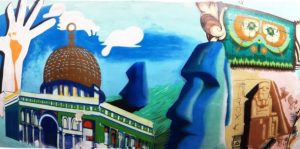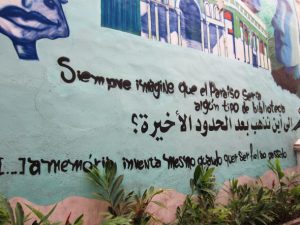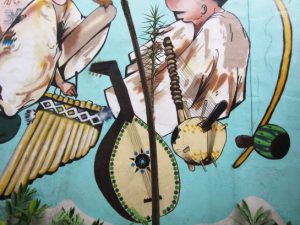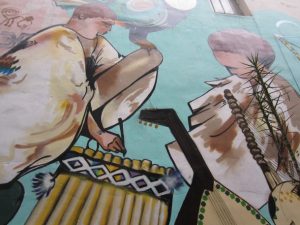Graffiti is an artistic expression that allows us to reflect on the proposed themes.
BibliASPA promotes meetings, debates and courses on representations of South Americans, Arabs and Africans that culminate in graffiti.
The graffiti in the BibliASPA space has 20 m x 10 m and presents some thematic grounds: Intellectuals, Locations, Literary Quotations, Fauna, Musical Instruments and Cultural and Educational Manifestations.
Writers
Machado de Assis (Brazil), Gabriel García Marquez (Colombia), Mahmud Darwich (Palestine), Naguib Mahfuz (Egypt), Edward Said (Palestine) and Cecilia Meireles (Brazil) represent South American, Arab and African intellectuals.
Places
Memorial of Latin America (Brazil). Sculpture by Oscar Nimeyer, with a blood map.
Mosque of the Dome of the Rock, Jerusalem
Moais on Easter Island (Chile)
Abu Simbel Complex (Egypt)
Nazca Culture (Peru)
Literary Quotations
Quotes from Jorge Luis Borges, Mahmud Darwich and Milton Hatoum:
“I always imagined that paradise would be a kind of library” (Jorge Luis Borges, Argentine writer)
“Where will we go after the last frontier?” (Mahmud Darwich, Palestinian poet)
“[…] memory creates even when it wants to be faithful to the past” (Milton Hatoum, Brazilian writer)
Hybrid animal gathers horse and zebra, symbolizing wildlife from the Arab countries and Africa. Tucano represents South America.
Musical Instruments from South America, Africa and Arab Countries
Berimbau – has an arch made of wooden rod, with a length of 1,20m to 1,60m, and steel wire attached to the ends of the pole. At one end of the arch is attached a gourd that functions as a resonance box.
Kora – has a resonance box made of gourd and strings originally of antelope skin. The player uses the thumb and forefinger of both hands to strum the strings. The sound produced by the kora is similar to that of the harp.
Lute – An instrument that has significant symbolic power in Arab culture and on which many studies on tuning in Arabic music are based. The lute arm, small and (currently) fretless, requires virtuosity and enables the creation of ornaments.
Zampoña – constituted by a set of graduated tubes closed at one end, of different sizes and connected to each other side by side. The instrument is blown and the sound is produced by the vibration of the air stream.
Cultural and educational manifestations
Education is a tool of transformation in any culture. Thus, a part of the graphite reiterates its role.
Arabic art par excellence, the calligraphy is also represented with prominence.
Arabic graffiti
Urban art in Buenos Aires







